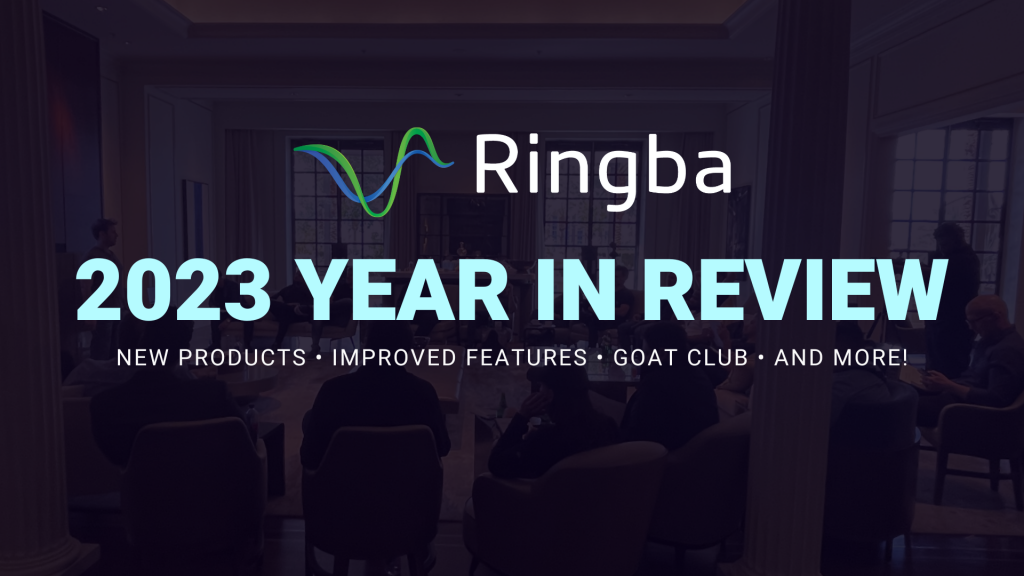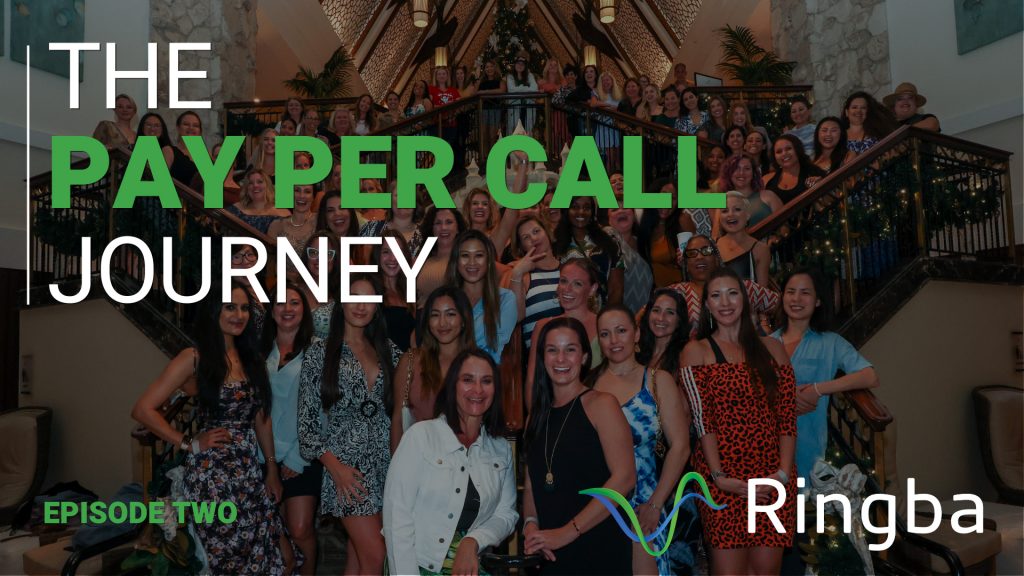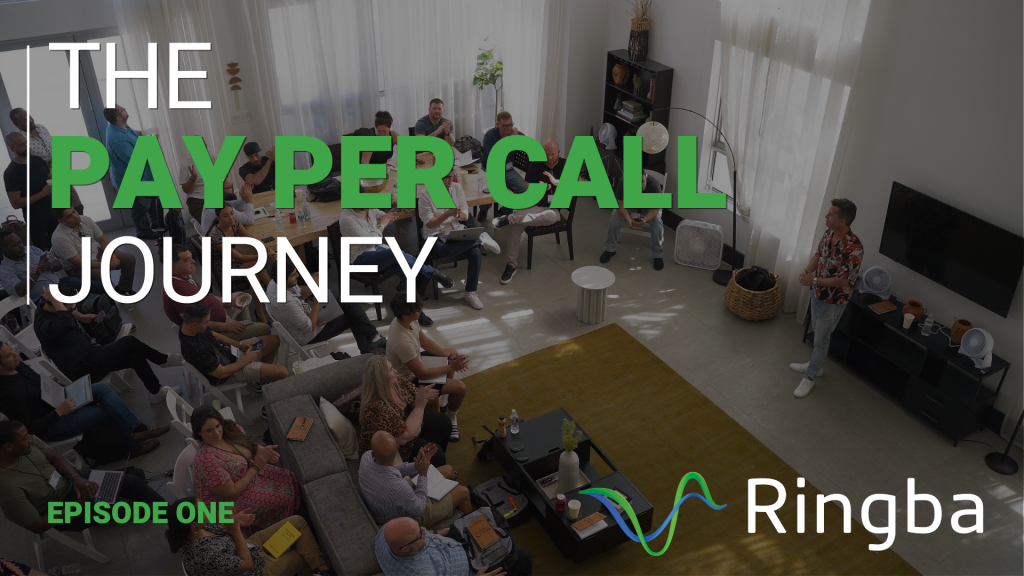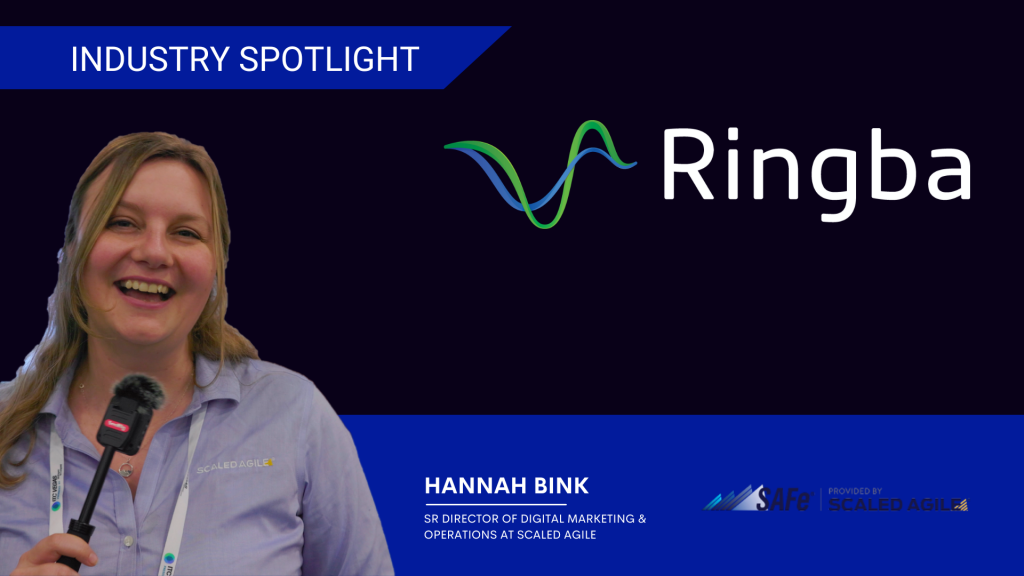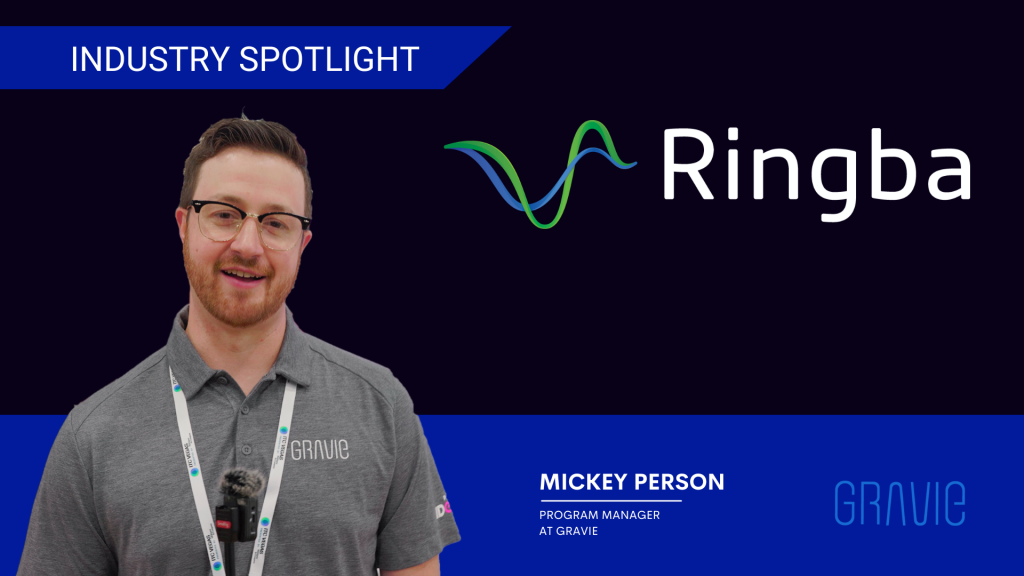Gain a complete understanding of the most common inbound call flows and how pay per call campaigns are managed on the back-end.
Contents:
– Understanding Call Flows
– Managing Call Flows
– Direct Buyer Call Flow
– IVR Input Qualification Call Flow
– Warm Transfer Call Flow
– Warm Transfer via Network Call Flow
– Multiple Brokers Call Flow
Understanding Call Flows
The critical difference between Pay Per Call any other type of affiliate or CPA marketing is the human element. Someone has to be available to take a customer call as soon as possible to achieve the highest conversion rate. The longer a customer waits on hold, the higher the probability that they will hang up the phone.
While it is possible to call the customer back or follow up with other methods like SMS; the likelihood that the customers intent or desire to have the conversation drops substantially. Your chances of getting that customer back on the phone with the same conversion rate as the original inbound call are virtually 0%.
That is why it is so essential to make sure your calls get answered in the shortest amount of time, and why you must have your own call tracking software.
Managing Call Flows
If you do not have your own call tracking platform, you cannot optimize, you have no quality assurance oversight, you have no guarantee of payment. You can’t dispute anything; you can’t say here’s the reporting, here’s the call log, here’s the record, give me my money. You effectively have nothing. You can’t oversee the network and keep them honest; you can’t monitor your buyers and keep them honest. You have no idea how many calls get answered, you have no idea if you’re dropping calls, or the buyer is dropping calls. You have no guarantee those calls get sold. You have no recourse if the networks tracking platform goes down. You have no recourse if another publisher or affiliate slams them with calls, so yours don’t get answered. And you have no payment for duplicate calls because there’s nowhere else for those calls to go.
For those of you who aren’t familiar, Ringba is a call tracking, attribution, routing, and management platform designed explicitly for Pay Per Callers regardless of where they sit in the value chain. All of our engineers are AdTech industry veterans who have built some of the most advanced technology in the space, and our goal is to change how people buy and sell their calls altogether.
We have a simple question we ask before we make any decision: does this help our clients grow their business?
We don’t do contracts, setup fees, minimums, gate-keep features, or anything designed to maximize the amount of money our clients pay us; rather we are working to maximize the amount of money our clients can make.
Ringba is the only call tracking company in the market that provides 1-on-1 support to all of our clients over chat, slack, skype, phone, and email. Whatever it takes to make you successful, we’re going to do it, and if we can’t, we’re not going to try to force you to stay with us. That’s lame.
Direct Buyer Call Flows
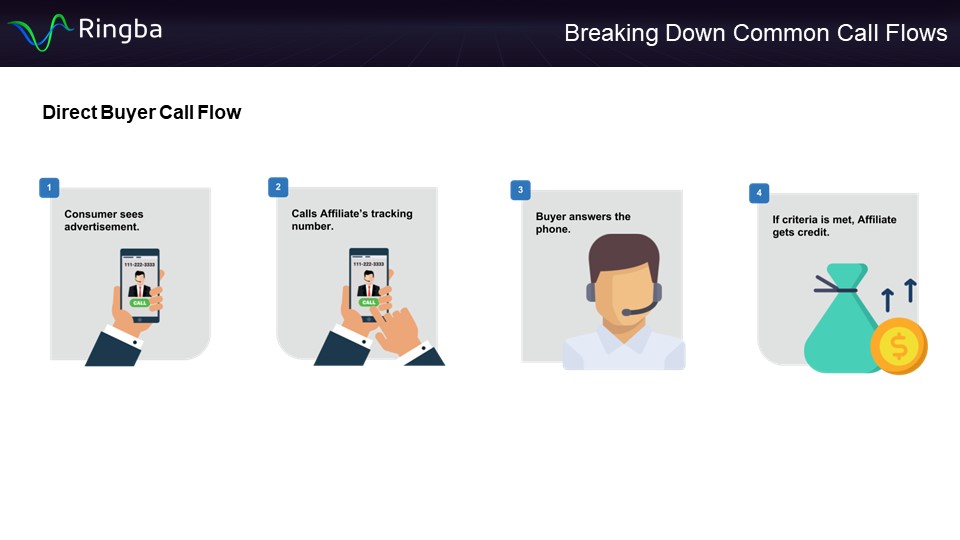
If you’re working with a direct buyer, you’ve got your call tracking all setup, this is how the most simple call flow works. A consumer is going to see an advertisement; they’re going to call your tracking number, it’s going to get routed to a buyer. They’re going to answer the phone, and if the criteria get met, the affiliate or the publisher gets a commission.
This is what this looks like in a flow:
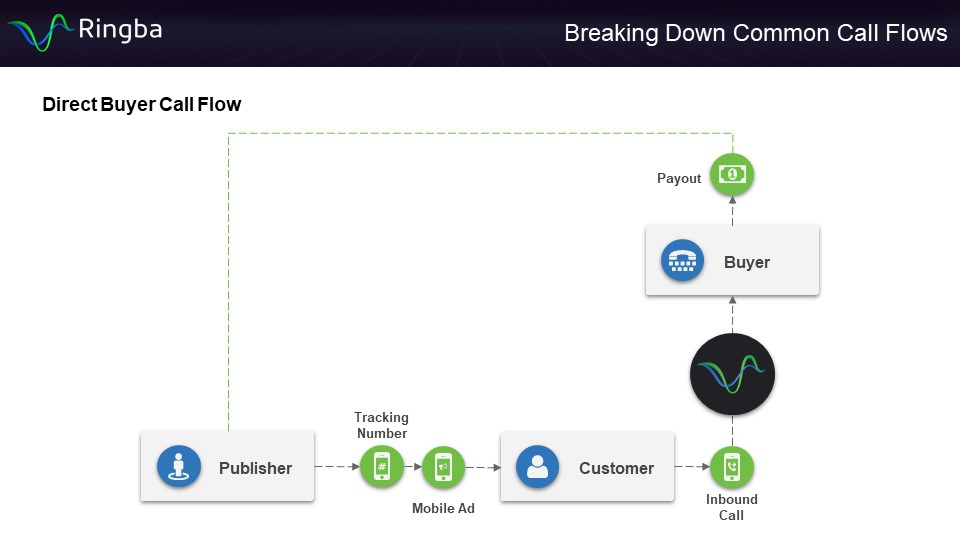
the publisher gets their tracking number from Ringba, they create a mobile ad, maybe they do that on Google. Or perhaps it’s not a mobile ad even; they put it on a billboard, a bus bench, whatever type of advertising medium they choose, they put the tracking number on it. Now when an interested consumer sees that number and wants the product or service, they’re going to pick up the phone. Ringba’s going to track that for you. And it’s going to route it to one of your buyers, based on whatever criteria gets set in there and we’re going to dive into the criteria in a later lesson, and how to do advance call flows, but what we’re going to do right now is break down what common ones look like.
IVR Input Qualification Flow
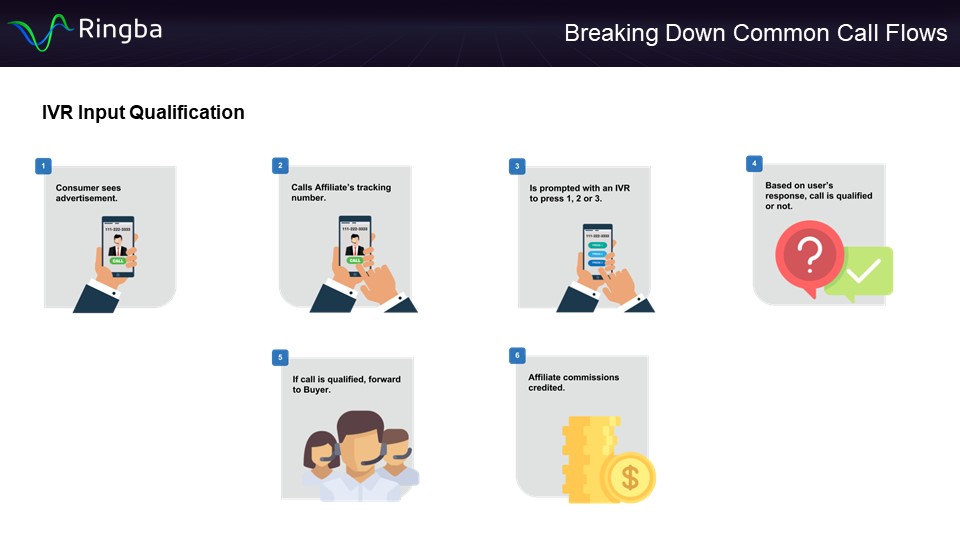
Next up, is an IVR input qualification. Step number one the consumer sees an advertisement. On the advertisement is the affiliates call tracking number. They’re going to pick up their phone, and they’re going to call that phone number because they’re interested in the product or service. Then they are presented with an IVR, which is the Interactive Voice Response. And they’re given a couple of choices like press one, press two, press three, etc. And based on the caller or users response, whatever they enter into the IVR, it determines whether the call is qualified or not. So if it’s a debt call, and we’re asking if the caller has more then $10,000 in unsecured credit card debt, if they have that they press one. If they don’t, they press two. So if they press one, it’s qualified, if they don’t, they press two, and it’s not qualified.
So if the call is qualified, it’s forwarded to a buyer, and then the affiliate gets credit or commission for that call. Now here’s what that flow looks like:
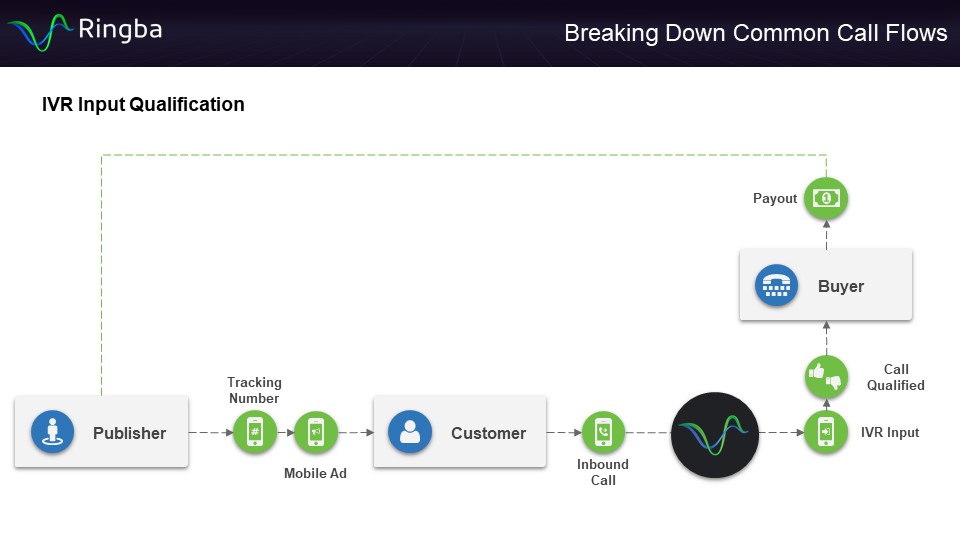
Again it’s very similar, and there’s only one difference. So the publisher starts by getting their tracking number from their tracking platform, they put an ad on the internet, or somewhere else with that tracking number on it. The consumer picks up the phone, they dial that number, all of their information, and all the metadata gets stored in the tracking platform. The tracking platform issues the IVR; maybe it’s text to speech, perhaps it’s a prerecorded IVR, who knows. The consumer makes an input, and if the call is qualified, it goes to the buyer. If the call has a different qualification, maybe there’s a different buyer that buys when user press two, or three or whatever. But for simplicity sake, the call is qualified, and then it is routed to the buyer. Buyer verifies the qualified calls. Meets all the criteria of their campaign, and then bam! Payout gets issued to the publisher, and the whole things tracked on your platform.
Warm Transfer Call Flow
Here’s what a warm transfer looks like:
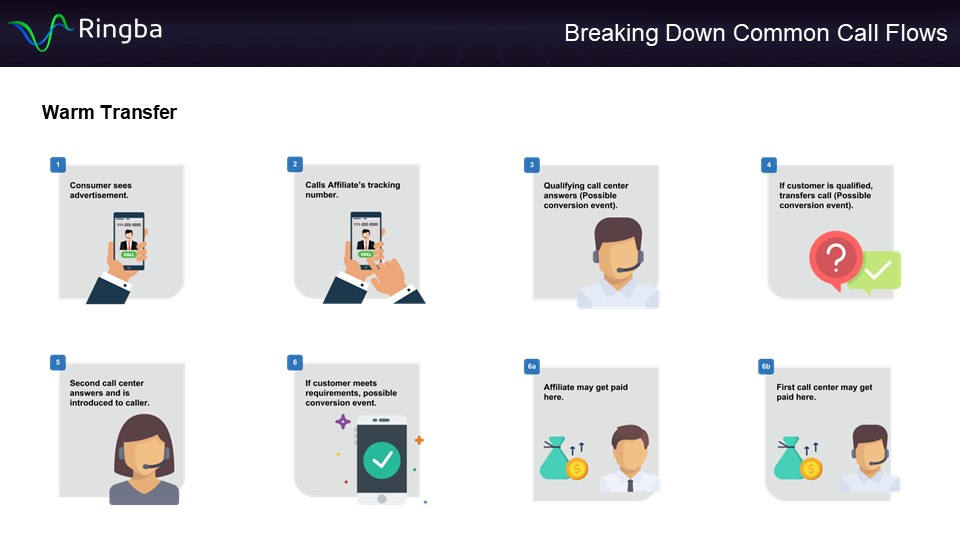
This one’s a little bit different, but this is a great business as well. So a consumer is going to see an advertisement, and that advertisement has the tracking number on it, so they pick up the phone, they call the affiliates tracking number. And then the first call center answers the phone. That is the qualifying call center. Now is it possible that there’s a conversion event right here for that inbound call? Sometimes there it is, sometimes it isn’t. It just depends on the campaign. But the agent that answers that call is going to ask a list of questions to try and qualify that caller to see if they’re a good fit for the campaign.
First of all, they’re going to ask, perhaps, what their name is, and what they’re calling about, and then maybe if it’s for car insurance, they’re going to ask if the person owns a car. Because if they don’t own a car, they’re not purchasing one right then, there’s no need to call an insurance line. So they’re going to qualify that person to see if it’s a good fit. Now if the customer is qualified, and that’s an if, they transfer the call to a second call center that answers and connects to the caller. So they’re going to say, “Okay, great, you qualify for this special deal, let me get you transferred over to Geico.” Or whoever it is, alright? Doesn’t matter, whoever answers it second, they connect, and a call handoff is in the making! Now once the call handoff gets made, if the customer meets requirements, there’s again a possible conversion event.
Typically in a warm transfer, the conversion event is on the transfer. And so once the call gets transferred to the second call center, that’s when the conversion event happens, and since it’s a human to human handoff, there are not many other criteria that typically goes with that. Because someone has already spoken to the caller and made sure that the call is legitimate, and so after it gets transferred the affiliate would usually receive their credit then. And then maybe the first call center that answered the phone also gets paid now. Because obviously, they need to make money too. So perhaps the affiliate receives $10 in commission, and the qualifying call center gets $10 in commission, but both of those events happen after the transfer.
Now here’s what that looks like:
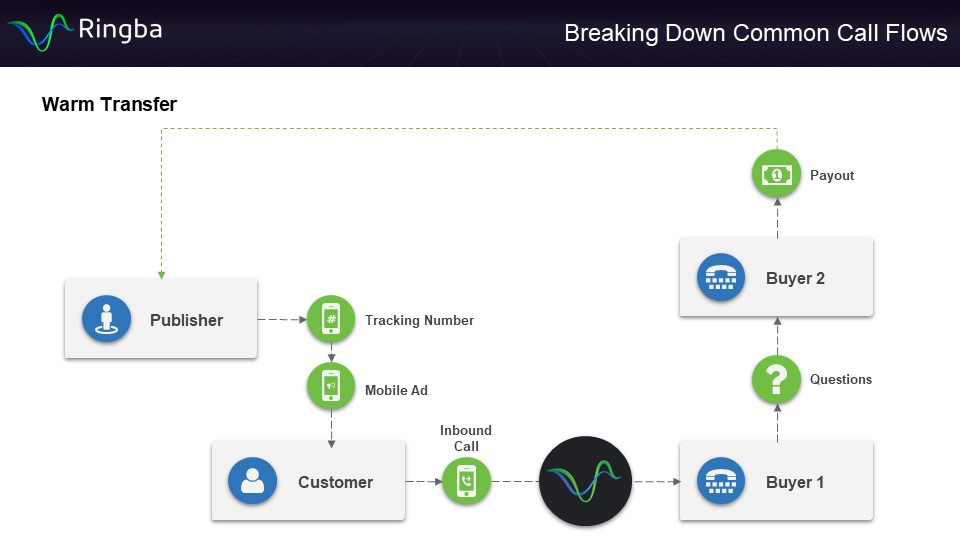
You have a publisher, they get their tracking number, and they put it on an advertisement somewhere. The consumer who’s interested in the product or service initiates that phone call. It’s tracked and routed by the call tracking platform and then a buyer, the first one, or the qualifying call center, whatever you want to call it, answers the phone, qualifies the customer with a bunch of questions, and then transfers the call off to the final buyer. The second buyer who takes it, and then issues a payout, back to the original publisher, and sometimes to the first call center depending on how that campaign is set up.
Warm Transfer via Network Call Flow
Now these also sometimes happens through a network, and so lots of people can have their hand in these calls, and it’s crucial to realize again that, just because you’re working with a network or doing a warm transfer, does not mean there aren’t other brokers in the process.
And so a warm transfer via a network typically looks like this:
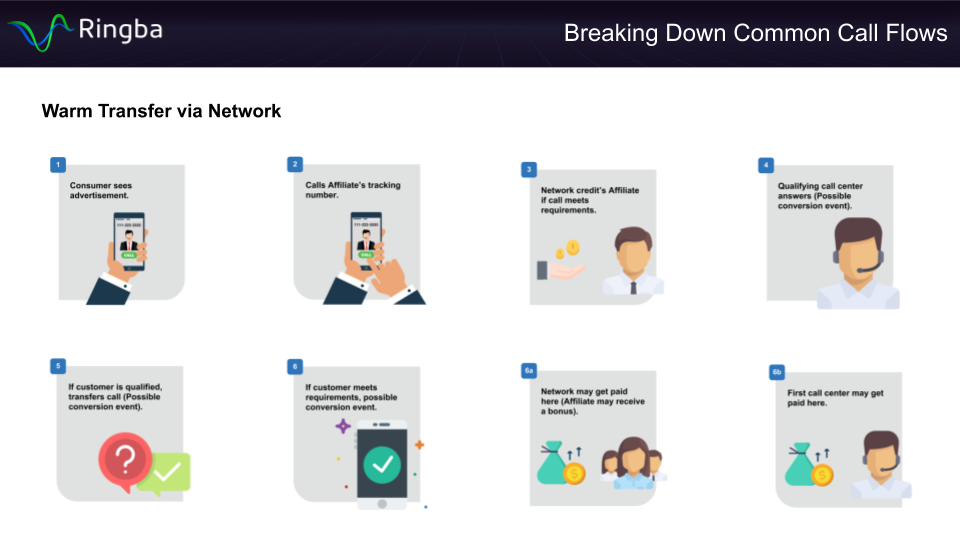
A consumer sees the advertisement, calls the affiliates tracking number, alright? And now the network is going to credit the affiliate if that call meets the requirements. So the affiliate’s going to get paid based on their inbound call. Now what’s happening here is the network most likely has a deal with the other call centers to convert them into qualified transfers. They’re the ones that are making the majority of the money here, and the affiliates are getting a tiny piece of the action. So the network again then transfers the call or routes the call through the call tracking platform to one of their buyers, which is going to be this qualifying call center.
Now it’s possible that there’s a conversion event at this juncture and the network receives a commission, or this call center qualifies the caller, and if the customer becomes qualified after asking them to transfer questions, they get transferred to the actual final buyer of the call. And so the network might get paid from the eventual buyer of the call, a substantial amount compared to what the affiliate gets paid. Do keep in mind that the affiliate may get paid sometimes when then calls don’t qualify, depending on how it’s set up. The network may get multiple payout events, again depending on how the campaigns set up. In this scenario, you can assume that the party making the most amount of money, outside of the buyer of the call, is going to be the network, not the affiliate.
This is what that looks like:
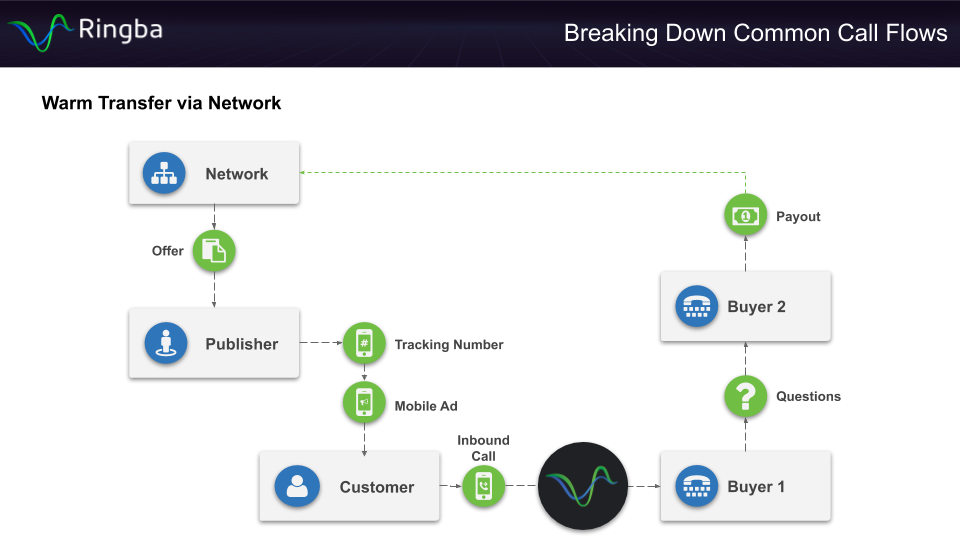
The network is going to get a bunch of buyers and set up the back end call centers, they’re going to figure out who’s going to qualify the campaign and then transfer it to their buyers. And they’re going to wrap that whole thing up and call it an offer. So as a publisher you’re going to go on the network, and you’re going to see the offer, you’re going to apply and get approved to that offer, you’re going to get your tracking number, you’re going to plug it into Ringba so that you have control. Then you’re going to put your Ringba number on that mobile ad or whatever advertisement that you’re going to run.
Then a consumer sees it, they’re interested, they dial the number, it routes through your call tracking platform, and then the network takes hold of it, and gets it to their first buyer, or their qualifying call center. The questions are asked to qualify that call; you have gotten paid already. And then if that call transfers to the actual final buyer, the payout is issued to the network, and that payout is going to be substantially more. Maybe 100, 200, 300, 500, 1000% more in some cases than what the affiliates getting paid.
Multiple Brokers Call Flow
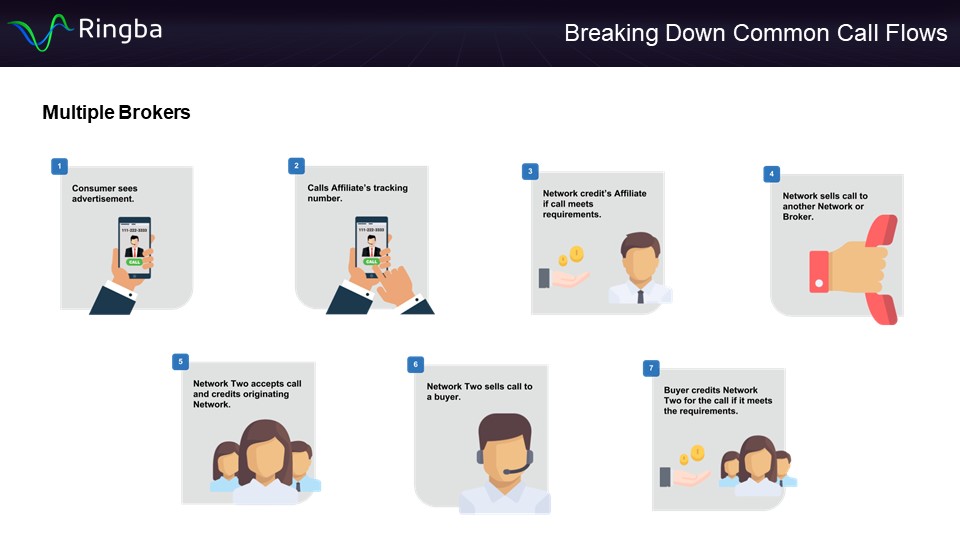
In this call flow, it goes through multiple brokers. Now, remember that I consider a broker anyone that’s not the final buyer of the call. So Pay Per Call Networks is a broker, someone that’s just pushing calls, and hustling connections is also a broker. You never really know how many people sit in the middle of these call flows unless you’re working with the call center that buys the calls.
In this call flow, a consumer is going to see the advertisement, and they’re going to call the affiliates tracking number, a network or some other type of broker is going to credit the affiliate with a commission if the call meets the requirements. Now the network sells the call to another network, so broker to broker action here, or another broker just someone slinging calls, we have no idea, and network two accepts the call and credits the first originating network with some commission. And network two sells the call to either a final buyer or believe it or not maybe even another broker, or warm transfer center, and there’s someone else in the value chain.
So there can be one, two, three, four, five brokers in these call flows. So when you start working with networks. You have to be careful about this, they may be paying you $6 a phone call, and by the time the final buyer pays for that phone call, they may have paid $45 or $55 or $100, for that phone call. So that’s why you need to understand what’s going on in your call flow so that you can figure out better ways to get closer to the buyers, create new opportunities for yourself so that you can grow your business.
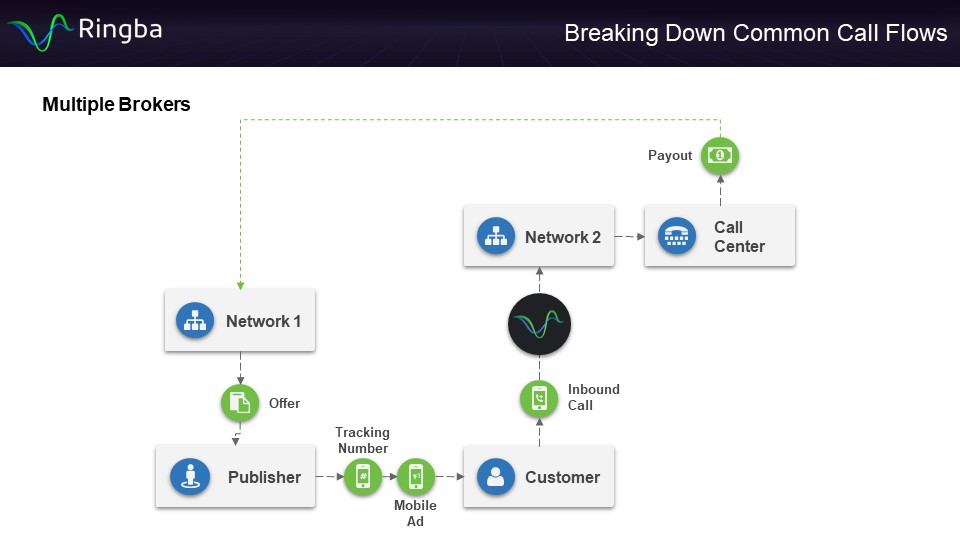
This is what that looks like in a diagram; network one is wrapping up the offer, whatever that offer may be, maybe just brokering it from the other one. Doing absolutely no work maybe, perhaps the network is not even providing any value, just brokering the offer. You as the publisher grab that offer, you get your tracking number from your tracking platform, you throw it on an advertisement somewhere, a consumer sees it, they call the inbound number. We track everything for you, and network two gets the call, finally transfers it to the call center and then the pay outflows back to network one and eventually to you. You then get your small fraction of the actual revenue that happens in this scenario when working with multiple brokers.

